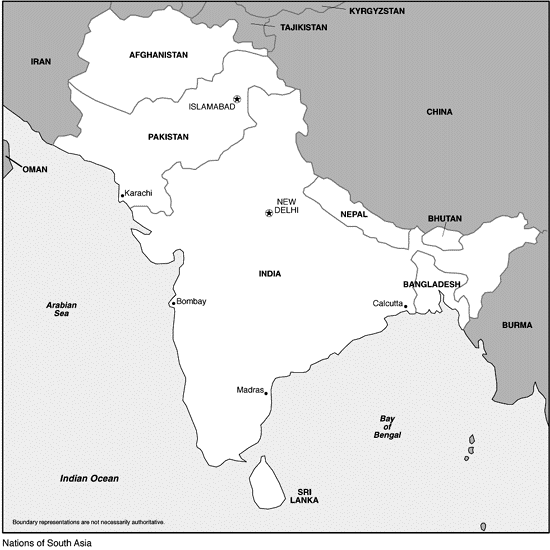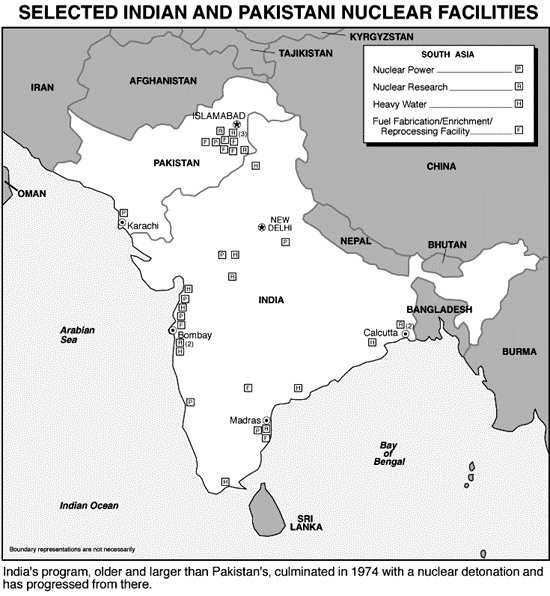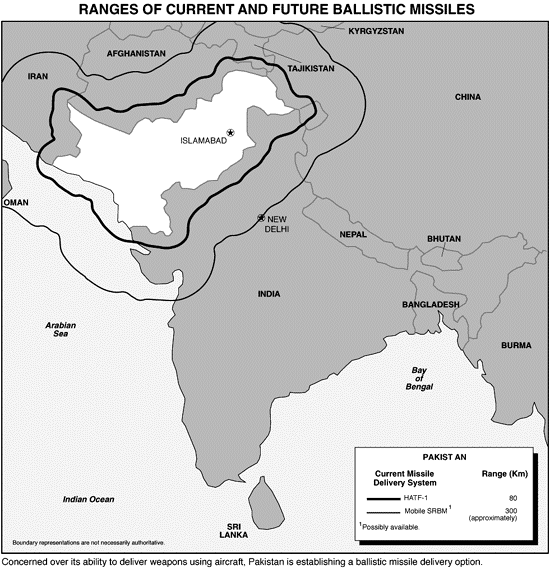

The United States has important security interests in South Asia, including preventing another Indo-Pakistani war and enhancing regional stability. Our nonproliferation goal is to persuade India and Pakistan to first cap, then reduce, and eventually eliminate their capabilities to produce nuclear weapons and ballistic missiles. This approach supports our global objective to reduce and ultimately eliminate nuclear weapons. The consequences of a nuclear war between India and Pakistan would be catastrophic, both in terms of the loss of life and for potentially lowering the threshold for nuclear use in other parts of the world, particularly the adjacent Middle East/North Africa region.
Deployment of ballistic missiles would pose especially troubling security risks given the relatively short distances between major population centers in South Asia and the brief time required for missiles to travel such distances. This factor will compress decisionmaking cycles for national leaders and battlefield commanders, reducing stability during times of crisis.
In addition to the immediate risks to regional security, the development of NBC weapons in South Asia has the potential to undercut broader U.S. and international nonproliferation objectives. Both India and Pakistan, for different reasons, have refused to sign the NPT. Their nuclear programs, outside of this widely accepted international norm, serve as dangerous examples for nations in other regions.
The NBC weapons and missile infrastructures in South Asia also pose potential proliferation threats, as possible sources of supply. India and Pakistan's slowness to adopt export controls consistent with established international control regimes is reason for concern. As each nation continues its programs, the danger of transferring technology to states outside the region remains possible.
India and Pakistan
The bitter rivalry between India and Pakistan, which dates to the partitioning of the subcontinent in 1947, remains the impetus behind the proliferation of NBC weapons and missiles in the region. The security dynamics of the region are complicated further by India's perception of China as a threat. Pakistan's efforts to develop NBC weapons and missile systems are intended primarily to counter India's substantial conventional military advantage and its perception of India's nuclear threat.
India and Pakistan continue to cloak their NBC weapons programs in secrecy or deliberate ambiguity. Both continue to deny possessing nuclear weapons, while periodically issuing veiled threats alluding to their capability to employ these weapons if necessary. India and Pakistan deny possessing chemical and biological weapons, but point with pride to the progress of their indigenous missile development programs.
India's pursuit of nuclear weapons was first spurred by a 1962 border clash with China and by Beijing's 1964 nuclear test. New Delhi continues to view its northern neighbor as a long-term threat despite recently improved relations. It sees Pakistan's NBC weapons and missile capabilities as a more immediate threat. Nuclear rhetoric from Pakistani leaders and Islamabad's pursuit of a mobile SRBM capability reinforce India's perception that New Delhi continues to need a nuclear capability.
Pakistani leaders believe that a nuclear capability is essential to deter war with India, or failing that, to ensure the survival of the nation. Its nuclear program has widespread political and popular support. Missile procurement and development, initially to counter the Indian missile program which began in the mid-1980s, are driven by a desire to augment limited offensive air capabilities against India (which holds almost a 3:1 advantage in combat aircraft) and to field a more effective delivery system.
NUCLEAR PROGRAMS
India's very active nuclear energy development program has enabled it to obtain all of the essential materials and facilities for producing nuclear explosives. It has not signed the NPT, but is a member of the IAEA, and several Indian nuclear reactors are subject to IAEA safeguards.
India's program, older and larger than Pakistan's, included a nuclear detonation in 1974, described by India as a "peaceful nuclear explosion." India is currently capable of conducting another test within a short time of deciding to do so. It has an advanced nuclear program, with facilities to support the complete nuclear fuel cycle. India produced its stock of weapons-grade plutonium in reactors at the Bhabha Atomic Research Center near Bombay, which are not subject to IAEA safeguards.

As additional indigenously-built nuclear power reactors become operational, India's capability to produce plutonium without safeguards will increase. India has the resources for producing and reprocessing plutonium and for enriching uranium. It also has the ability to conduct nuclear tests, which would support attempts to produce more advanced weapons. However, New Delhi's willingness to refrain from conducting additional nuclear tests could inhibit the development of such weapons.
India is believed to have a stockpile of fissile material sufficient for fabricating several nuclear weapons and could probably assemble at least some of these weapons within a short time of deciding to do so.
Pakistan began its nuclear weapons program in response to losing the 1971 war with India and accelerated it following India's 1974 nuclear test. Pakistan has not signed the NPT, but it has taken the public position that it would do so if India were to sign it also. Like India, not all of Pakistan's nuclear facilities are under IAEA safeguards.
Relying heavily on foreign assistance, Pakistan has developed a diverse, clandestine procurement network to support its weapons development effort. Although it has become increasingly self-sufficient in producing highly enriched uranium and in engineering and fabrication technologies, Pakistan will remain dependent on foreign suppliers for sophisticated materials and technical assistance necessary to improve and expand its nuclear program. China remains an important supplier of nuclear technologies to Pakistan. In addition, Pakistan has acquired or attempted to acquire various materials and technology for nuclear weapons and peaceful applications from firms in the United States and Western Europe.
Most of Pakistan's nuclear research and development is conducted by its Atomic Energy Commission, which operates over a half-dozen facilities throughout the country. Three of Pakistan's operating nuclear reactors -- the KANUPP power reactor in Karachi and the PARR I and PARR II research reactors near Islamabad -- are under IAEA safeguards. The Chashma nuclear power plant, also near Islamabad, is under construction and also will be covered by IAEA safeguards.
Pakistan possesses all the components necessary for producing a nuclear device, and it probably has sufficient fissile material now to assemble a few nuclear weapons. In addition, Pakistan is building an unsafeguarded nuclear reactor that will provide it with a substantial capability to produce weapons-grade plutonium. It is expected to become operational in the late 1990s.
CHEMICAL AND BIOLOGICAL PROGRAMS
India and Pakistan are capable of developing chemical weapons. India, a signatory of the CWC, has never admitted to having an offensive chemical warfare program. India's large chemical industry produces many dual-use chemicals that could be used as precursors, and could support a chemical warfare program of considerable size.
Like India, Pakistan has signed the CWC, and can produce chemical agents and munitions. It has procured dual-use chemical precursors from foreign sources and hopes to achieve self-sufficiency in producing precursors.
While India possesses the infrastructure necessary to support an offensive biological warfare program, including highly qualified scientific personnel and industrial production facilities, it apparently has given priority to research and development applicable only to biological warfare defensive measures. Pakistan has the resources and capabilities appropriate to conducting research and development relating to biological warfare. Both countries have signed the Biological Weapons Convention.
BALLISTIC MISSILES
India has one of the more self-sufficient ballistic missile programs in the developing world. It can design and produce missiles with little foreign assistance. However, New Delhi is working to become self-sufficient in all areas of production by the end of the decade. India has two ballistic missile programs -- the Prithvi SRBM and the Agni MRBM. The Indians heavily used technological assistance and parts from Western firms in developing these missiles. The Prithvi is a single-stage, liquid-fueled missile using propulsion technology from the Soviet SA-2 surface-to-air missile, and is designed to be deployed with a payload of 1,000 kilograms to a range of 150 kilometers (or 250 kilometers with a 500-kilogram payload). The Indian Army has completed user trials with the Prithvi. The missile could quickly enter series production if a deployment decision were taken.
In 1994, India successfully tested the two-stage Agni; the missile achieved a range of 1,000 kilometers, about half its intended range. Publicly, the Indians call the missile a "technology demonstrator," although it could be used in developing a follow-on, longer range MRBM that could reach China.
Additionally, India has had an ambitious space launch vehicle (SLV) program since the mid-1970s. The program includes three SLVs, which have payload capacities ranging from 150 to 3,000 kg. India could convert these SLVs into IRBMs or ICBMs quite easily but has shown no indications of doing so. It has already built guidance sets and warheads, key components needed to convert an SLV into a ballistic missile.
The Indian space program shares research, development, and production facilities with the ballistic missile program. Therefore, New Delhi could apply the SLV technology it has obtained from the former Soviet Union and the West to its ballistic missile programs.
Pakistan has an SRBM industry that includes a large solid rocket motor production complex and a ballistic missile test facility. However, Pakistan's missile production capability is not as extensive as India's. So far, it has produced only a few Hatf-I SRBMs, which have a range of 80 kilometers and are regarded as inaccurate.

China remains Pakistan's most important supplier of missile-related technologies. The United States imposed Category II sanctions against entities in both countries in August 1993 for transferring M-11 related components and technology to Islamabad. In 1994, the sanctions against Beijing were lifted when China reaffirmed its bilateral commitment to the United States to adhere to the Missile Technology Control Regime and made a number of new, related commitments.

CRUISE MISSILES AND OTHER MEANS OF DELIVERY
India has Russian and British ship- and air-launched anti-ship missiles, while Pakistan has Chinese and U.S. ship- and submarine-launched and French air-launched anti-ship missiles. Because India is still developing ballistic missiles, combat aircraft currently are its most viable delivery vehicles for nuclear or chemical weapons. The most likely platforms are the Mirage 2000, MiG-27, MiG-29, and Jaguar. Similarly, combat aircraft are Pakistan's most viable delivery means for NBC weapons, with the most likely platforms being F-16 and Mirage III fighters.
| INDIA AND PAKISTAN: STATUS OF PROGRAMS | |
|---|---|
| Nuclear Weapons | * Both possess fissile material. |
| Chemical Weapons | * India, with its large industrial base, can produce precursors for chemical warfare agents. |
| * Pakistan must obtain precursors for chemical agent production. | |
| Biological Weapons | * Pakistan is conducting research and development with potential biological warfare applications. |
| * India's efforts are geared towards defense. | |
| Delivery Systems | * Both have aircraft capable of delivering nuclear and chemical weapons. |
| * Both are developing missiles. | |
| ** India: Has two missile programs: - Prithvi - short range (150-250 km) - Agni - intended range (2,000 km) | |
| ** Pakistan: Has two missile programs: - Hatf I - short range (80 km) - Mobile SRBM - approximately 300 km range | |